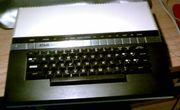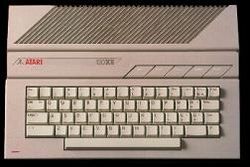Atari 400 & 800[edit]
| Atari 400 | |
|---|---|
 | |
| Manufacturer | Atari |
| Released | 1979 |
| Total Games | 126 (144 present) |
| ← (none) | (none) → |
The Atari 400 and 800 were the first home computers to use custom co-processors and the first to use "sprites" and special video interruptions like display lists, features that would be implemented later on the Commodore 64 and Amiga (The Atari 400/800 and the Amiga were both designed by Jay Miner).
It offered high graphic resolution, lots of colors and great sound capabilities, more than other computers could do then! The two models had the same computational power. The 400, which was the low-cost version, had only 16 KB memory, one cartridge port, and a membrane keyboard. The more expensive 800 had 48 KB of RAM, two cartridge ports and a proper mechanical keyboard
| Atari 800 | |
|---|---|
 | |
| Manufacturer | Atari |
| Released | 1979 |
Originally, the 400 was sold with 8 KB RAM, but later most 400's were equipped with 16 KB. The very first Atari 800 Computers were shipped with 8 or 16 KB memory, expandable to 48 KB. After the initial release, the 800 came standard with 48 KB memory.
Atari 1200XL[edit]
| Atari 1200XL | |
|---|---|
 | |
| Manufacturer | Atari |
| Released | 1982 |
The Atari 1200 XL was the predecessor of the Atari 600/800 XL. It had much of the same characteristics, except the size of its ROM (16 KB instead of 24 KB), with the BASIC Interpreter being supplied on a cartridge. Because the built-in Operating System was not designed very well, people are known to have swapped the OS ROM chip from their 800XL & put in the 1200 XL.
This machine was a flop in the marketplace and would be produced for only 4 months before being replaced with the 600 & 800 XL machines. This computer was not distributed in Europe.
Atari 600XL & 800XL[edit]
| Atari 800XL | |
|---|---|
 | |
| Manufacturer | Atari |
| Released | 1983 |
| Atari 600XL | |
|---|---|
 | |
| Manufacturer | Atari |
| Released | 1983 |
The Atari 800XL, together with the 600XL, were successors of the Atari 400/800 series and the unsuccessful Atari 1200 XL in a more compact case. They could use almost the same software, just so long as the program was written correctly, because of some slight differences between OS versions.
The 800XL had 64 KB of RAM, two joystick ports and kept all the custom chips (Pokey, GTIA, Antic) of the previous models. It also featured the new Parallel Bus Interface (PBI) providing high speed access to the system bus. The new version of the graphic Antic chip offered 16 graphics modes instead of 12 for the 800.
An enhanced version, called 800XLF, appeared in summer 1984. It was equipped with the new "Freddie" chip which allowed faster memory management, especially for graphics display. This version was released in Europe with SECAM video interface.
Alongside the Commodore 64 and the Apple II, the 600 and 800XL were among the most popular home computers. They would be replaced in 1985 with the XE series when Atari launched the ST.
Atari 65XE & 130 XE[edit]
| Atari 130XE | |
|---|---|
 | |
| Manufacturer | Atari |
| Released | 1985 |
| Atari 65XE | |
|---|---|
 | |
| Manufacturer | Atari |
| Released | 1985 |
The Atari 130-XE was first shown at the Winter Las Vegas Consumer Electronic Show in 1985 (with the Atari 130 ST), it has the same characteristics as the Atari 800 XL except its added memory (128 KB instead of 64 KB for the 800 XL). The extended memory can be used as a RAM disk, or can be accessed by bank switching routines.
It was an attempt to extend the life of the old XL series, but Atari abandoned it pretty quickly to concentrate on promoting the ST series, which uses the same case style. The Atari 65-XE and 130-XE had a very short life due to the 16-bit home computer competition.
Several other XE machines were also produced :
- The Atari 65-XE (which is exactly like the 800 XL, except for the rear parallel connector, which it doesn't have),
- the Atari XE Game Console (1987) which is a 65-XE with an optional detachable keyboard. It was Atari Corp.'s attempt to do what they felt the 5200 should have been.
- The 65-XEM (a computer with a special custom sound chip called "Amy"). Reports stated that the Amy chip sounded better than the Commodore 64's SID chip (!). This machine would never be released,
- The 65-XEP (Atari's answer to the Commodore SX-64, it would never be released either),
- A modified 65XE was sold in Europe as the 800XE.
Atari XE Game System[edit]
| Atari XE Game System (XEGS) | |
|---|---|
 | |
| Manufacturer | Atari |
| Released | 1987 |
Atari's final 8-bit line system was the Atari XEGS (XE Game System). Launched in 1987, the XEGS was the first (and only) system in the 8-bit computer line to actually be advertised as a game system. The XEGS was created solely to compete with the NES and SMS (along side the 7800).
The XEGS was basically a repackaged 65XE with Missile Command built in. However since the XEGS was using virtually the same technology as the 400/800 did in 1979, it looked and felt very dated. To compensate for the lack of power, Atari released many new game cartridges in an attempt to wow gamers with the number of available titles (quantity not quality). Unfortunately most of these 'new' games were simply ports of games that had been available on tape and disks years earlier, although a few new original titles managed to slip in.
In 1989 the XEGS and the entire 8-bit line were quietly cancelled, bringing to an end one of the most impressive series of computers in gaming history. For more information, please see The XEGS entry at Atari HQ.
Pages in category "Atari 8-bit"
The following 144 pages are in this category, out of 144 total.

